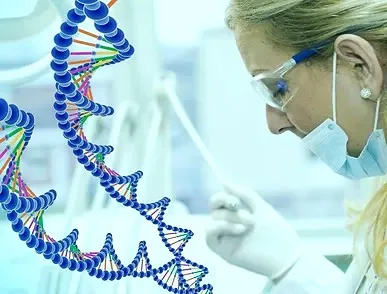How Our DNA Crafts Novel Genes
Unlocking the Genetic Fast-Forward Button
Scientists at the University of Helsinki in Finland have made a ground-breaking discovery: they have discovered a fascinating mechanism within our DNA (Deoxyribonucleic acid) that functions as a genetic fast-forward button, enabling the rapid creation of new genes for rapid adaptation to our constantly changing environments.

During a study focused on DNA replication errors, researchers stumbled upon an intriguing process triggered by specific single mutations, resulting in the formation of palindromes—sequences that read the same backward and forward. Remarkably, under certain conditions, these palindromes can evolve into microRNA (miRNA) genes.
MicroRNA genes, though simple in structure, play a crucial role in regulating other genes. While many miRNA genes have been present throughout evolutionary history, the study revealed the emergence of brand-new miRNA genes in certain animal groups, such as primates.
Bioinformatician Heli Mönttinen, the first author of the study, expresses the researchers’ fascination with the phenomenon, stating, “We now have an elegant model for the evolution of RNA genes.”
This efficient method of gene creation is attributed to template-switching mutations (TSMs), which allow the rapid development of miRNA genes—a process much faster than the evolution of new functional proteins.
“DNA is copied one base at a time, and typically mutations are erroneous single bases, like mis-punches on a laptop keyboard,” says project leader and bioinformatician Ari Löytynoja. The group concentrated on template-switching mutations, which are similar to copy-pasting text from another context in that they result in larger errors.
The study concentrated on microRNA genes, consisting of approximately 22 base pairs. Despite the complexity, TSMs can swiftly produce full DNA palindromes, converting previously noncoding DNA sequences into new microRNA genes.
Biotechnologist Mikko Frilander elaborates on the significance of palindromic sequences, stating, “In an RNA molecule, the bases of adjacent palindromes can pair and form structures resembling a hairpin. Such structures are crucial for the function of the RNA molecules.”
Comparing the genomes of various primates and mammals using a custom computer algorithm, the researchers identified microRNA palindrome pairs in the primate family tree. The findings suggest that a single mutation event can create entire palindromes, leading to the formation of new miRNA genes.
The study’s visual representation illustrates the process, wherein DNA replication encounters a mutation, jumps to the adjacent template, and replicates the instructions backward, creating a palindrome that forms a hairpin structure.
This mechanism is significantly more efficient than gradual changes occurring with individual building blocks. Over 6,000 such structures were found in the primate family tree, potentially giving rise to at least 18 new miRNA genes in humans—26 percent of all miRNAs thought to have emerged since primates first appeared.
The implications of this discovery extend beyond evolutionary lines, suggesting a universal miRNA gene creation mechanism. The team believes that these results can be applied to other RNA genes and molecules.
The study underscores the ease with which new microRNA genes can emerge, potentially influencing human health. Some TSM-associated miRNAs, like hsa-mir-576, have already demonstrated functional significance by impacting the antiviral response in primates.
Conclusively, the results indicate that our genomes are being shaped by a dynamic and continuous TSM process, providing an insight into the complex processes through which our DNA changes and adapts. The study represents a critical turning point in our knowledge of genetic innovation and has been published in the Proceedings of the National Academy of Sciences.
References:
Charpentier E., Marraffini L.A. Harnessing CRISPR-Cas9 immunity for genetic engineering. Curr Opin Microbiol. 2014;19:114–119. [PMC free article] [PubMed] [Google Scholar]
Hsu P.D., Lander E.S., Zhang F. Development and applications of CRISPR-Cas9 for genome engineering. Cell. 2014;157:1262–1278. [PMC free article] [PubMed] [Google Scholar]
Knott G.J., Doudna J.A. CRISPR-Cas guides the future of genetic engineering. Science. 2018;361:866–869. [PMC free article] [PubMed] [Google Scholar]
Cox D.B., Platt R.J., Zhang F. Therapeutic genome editing: prospects and challenges. Nat Med. 2015;21:121–131. [PMC free article] [PubMed] [Google Scholar]
Wang H., La Russa M., Qi L.S. CRISPR/Cas9 in genome editing and beyond. Annu Rev Biochem. 2016;85:227–264. [PubMed] [Google Scholar]

Can you be more specific about the content of your article? After reading it, I still have some doubts. Hope you can help me.
What a magnificent post! Your ability to distill complex concepts into understandable and engaging content is exceptional. I admire your commitment to providing value to your readers. Your blog is a treasure trove of knowledge. Thank you for your hard work.
A refreshing take on the subject, like a cool breeze on a hot day. I’m all ears for what you have to say next.
I’m officially a fan of The work. It’s like having a crush, but intellectually stimulating.
Adding value to the conversation, because what’s a discussion without The two cents?
Adding value to the conversation, because what’s a discussion without The two cents?
You’ve done a fantastic job of breaking down this topic, like unlocking a door to a secret garden. Intrigued to explore more.
Explaining things in an understandable way is a skill, and you’ve mastered it. Thanks for clearing things up for me.
The ability to connect with readers is like a secret handshake, making us feel part of an exclusive club.
The writing style is captivating! I was engaged from start to finish.